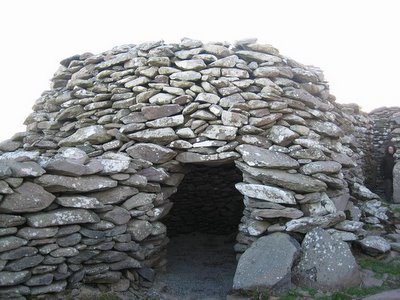
Prehistoric beehive hut near Slea Head, Dingle peninsula, County Kerry, Ireland. Slea Head is the most Westerly point of Europe.
"Ringforts are the most numerous and widespread field monuments in Ireland. These sites were commonly referred to by the terms Fort, ráth, lios, cathair or caiseal, the individual site names often incorporating one or other of these terms. Ráth and lios usually apply to earthen banked ringforts and cathair and caiseal to stones cashels.
The majority of these were enclosed farmsteads of the free farmers of the Early Christian Period, the banks and fosses acting as a fence to prevent livestock from straying and to protect against cattle raiders and wild animals. The small size of the sites suggests they were occupied by a single family, the houses, farm buildings and storage places occurring within the enclosed space. They would have been inhabited from ancient times to 1200AD.
These huts were often found attached to each other with a doorway leading from one to the other. These houses were generally made of stone because stone was plentiful. They were generally round like a beehive and a special type of craftsmanship is apparent in the building. They were erected in the form of a circle of successive strata of stone, each stratum lying a little closer to the centre than the one beneath and so on upwards until only a small aperture is left at the top which can be closed with a single flagstone or capstone. No mortar was used in building. The stones have a downward and outward tilt so as to shed the water. This method of building is called corbelling.
This Cashel is called Cathair na gConchúireach (Caher Conor). It is now occupied by five structures, one souterrain is visible and one of the structural stones in the cashel wall bears an inscribed cross."
"Ringforts are the most numerous and widespread field monuments in Ireland. These sites were commonly referred to by the terms Fort, ráth, lios, cathair or caiseal, the individual site names often incorporating one or other of these terms. Ráth and lios usually apply to earthen banked ringforts and cathair and caiseal to stones cashels.
The majority of these were enclosed farmsteads of the free farmers of the Early Christian Period, the banks and fosses acting as a fence to prevent livestock from straying and to protect against cattle raiders and wild animals. The small size of the sites suggests they were occupied by a single family, the houses, farm buildings and storage places occurring within the enclosed space. They would have been inhabited from ancient times to 1200AD.
These huts were often found attached to each other with a doorway leading from one to the other. These houses were generally made of stone because stone was plentiful. They were generally round like a beehive and a special type of craftsmanship is apparent in the building. They were erected in the form of a circle of successive strata of stone, each stratum lying a little closer to the centre than the one beneath and so on upwards until only a small aperture is left at the top which can be closed with a single flagstone or capstone. No mortar was used in building. The stones have a downward and outward tilt so as to shed the water. This method of building is called corbelling.
This Cashel is called Cathair na gConchúireach (Caher Conor). It is now occupied by five structures, one souterrain is visible and one of the structural stones in the cashel wall bears an inscribed cross."
No comments
Post a Comment